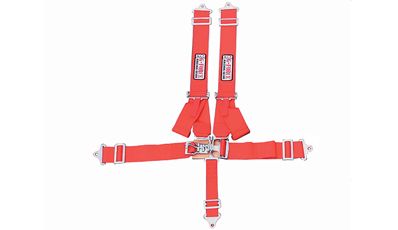
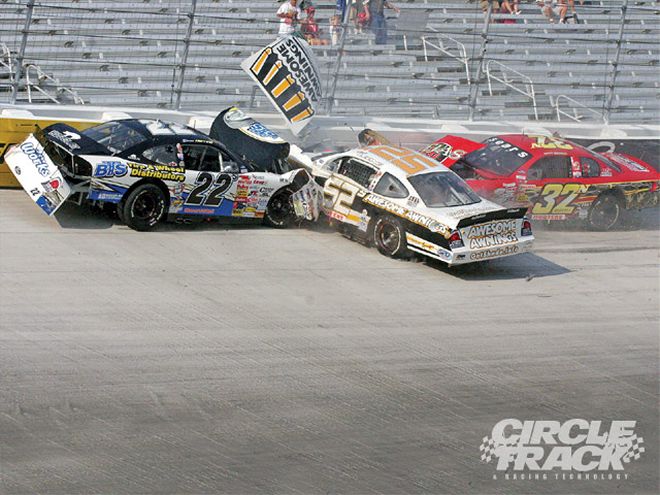 An accident like this will certainly rock anyone's world. The integrity of your seatbelts will have a huge outcome on whether or not you walk away from an accident like this. Photo by Todd Ridgeway
An accident like this will certainly rock anyone's world. The integrity of your seatbelts will have a huge outcome on whether or not you walk away from an accident like this. Photo by Todd Ridgeway
I will admit there are so many choices when it comes to racing seatbelts these days that it makes it very easy to overlook the critical factors in choosing them. Choosing a good set can be challenging, confusing, and a little intimidating. But seatbelts are important, so don't ever find yourself just settling for a set of belts. You should pay close attention to the SFI safety ratings and the age of your seatbelts.
Before we get too far into this, resist the temptation to buy your seatbelts based solely on brand. The safest set of belts for your particular application may just be from a manufacturer that you have never considered. I say that to remind you that, more than anything, seatbelts are designed to save your life. There is no reason to purchase an unsafe set of seatbelts just because they are cheaper than those from all of the other manufacturers, or because of some past grievance or bias toward a particular company.
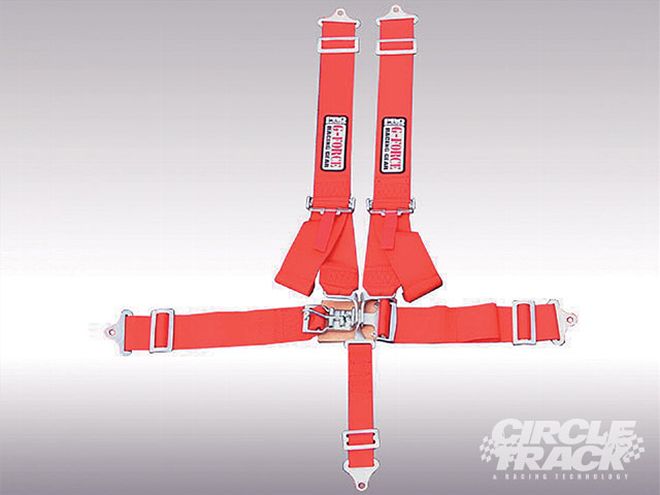 Here is a NASCAR-style five-point harness from G-Force that utilizes the latch and link system. G-Force also has a program that will allow you to send back your outdated belts to be inspected and re-webbed. The company will also update the SFI rating to ensure that your belts are good for another two years. Courtesy of G-force
Here is a NASCAR-style five-point harness from G-Force that utilizes the latch and link system. G-Force also has a program that will allow you to send back your outdated belts to be inspected and re-webbed. The company will also update the SFI rating to ensure that your belts are good for another two years. Courtesy of G-force
A lot of readers might be thinking right now, What's the point of this? My seatbelts are fine. A seatbelt is a seatbelt. Let me go on the record as saying that this is very dangerous thinking. Don't have the attitude that you are invincible. The responsibility rests upon you and you alone to ensure that your car is as safe as it can be. The seatbelts you choose to run are the only equipment that will prevent you from flying out of your seat during an accident.
First, to better understand seatbelts, we need to understand their function and design. The seatbelts used in today's race cars are made up of two shoulder harnesses, a lap belt, and either one or two anti-submarine belts. These are connected by either a cam lock system or a latch and link system.
A lot of belts today are still being made out of nylon. However, within the past 10 years manufacturers have learned that nylon webbing grows weaker over time, so most manufacturers are now using better and stronger polyester webbing instead of nylon.
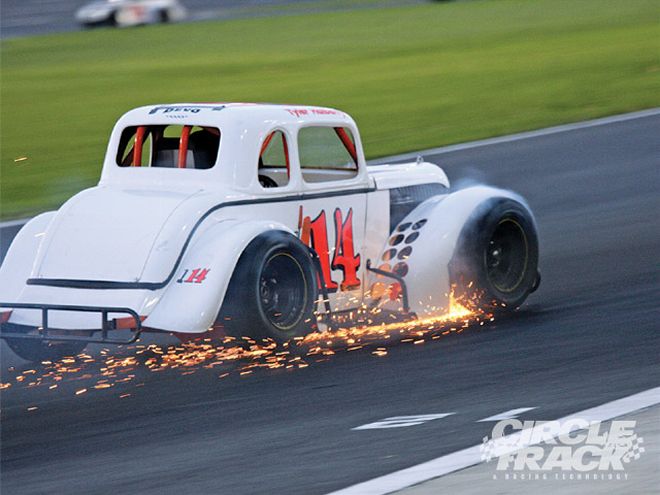 A lot of times it's the accidents that appear the smallest that can cause the most injury to a driver. Photo by John Gibson
A lot of times it's the accidents that appear the smallest that can cause the most injury to a driver. Photo by John Gibson
The reason that belts are webbed or woven is it makes the belts stronger. It makes them more unlikely to encounter a tear, become frayed, or snap. Let me be the first to say that if you snap one of these belts, you have really done something. NASCAR's latest rules say that a belt must be able to withstand 15,000 pounds of dead weight before it breaks. That's a lot of stress on the belt.
The SFI Foundation, a non-profit organization that issues and administers standards for specialty/performance automotive and racing equipment, has performed studies with nylon versus polyester belts. What they found was that polyester belts are more than 20 percent stronger than typical nylon webbing.
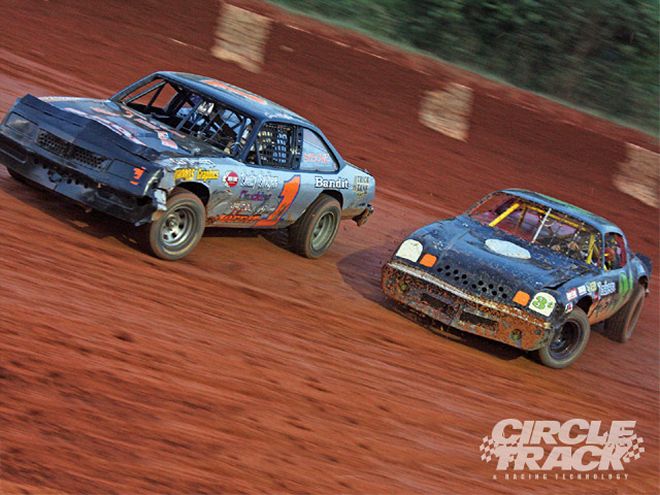 No matter what type of vehicle you are driving, you should inspect your seatbelts after each race weekend to look for cuts and frayed ends on the belts. If you find either, you should replace your belts immediately. Photo by John Gibson
No matter what type of vehicle you are driving, you should inspect your seatbelts after each race weekend to look for cuts and frayed ends on the belts. If you find either, you should replace your belts immediately. Photo by John Gibson
Simpson Race Products has also tested and uses polyester. As a result of their testing, they have published some rather amazing stats. One of the most impressive is that at 2,500 pounds of force, nylon belts will elongate (stretch) 15-17 percent their normal length. The elongation on polyester at the same amount of force is only 7-9 percent. Further, the nylon webbing has a tendency to absorb water, and when it gets wet it loses some of its strength, approximately 12 percent. However, Simpson's testing concluded that belts made primarily of polyester webbing lost no strength when exposed to water. This is the reason that Simpson is currently manufacturing two different sets of polyester belts, the most popular being the platinum-style safety belt.
Polyester's strength and durability is the primary reason German harness maker Schroth Racing Harnesses have always used it in their harnesses. Schroth harnesses offer a unique "memory effect" designed into their webbing. Special mono filaments laterally woven in perform like small leaf springs and keep the webbing flat. This results in better load spreading over the full width of the webbing. Another benefit of the Schroth webbing, the special weaving technology forms round edges for additional comfort.
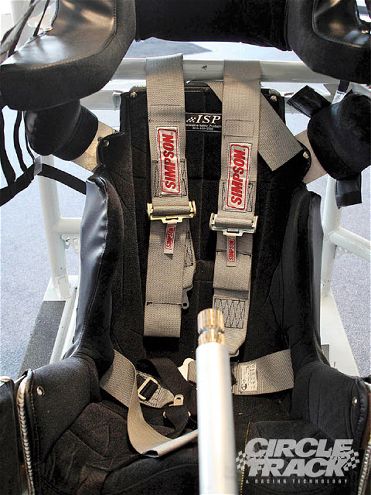 These are Simpson's Platinum series seatbelts. These belts (like other manufacturers) are made out of polyester webbing. Polyester is stronger and more durable then the older nylon belts. Photo by Jeff Huneycutt
These are Simpson's Platinum series seatbelts. These belts (like other manufacturers) are made out of polyester webbing. Polyester is stronger and more durable then the older nylon belts. Photo by Jeff Huneycutt
Of course, all of the design and safety ratings of the seatbelts are useless if the belts are not properly installed on the chassis. We won't go completely into every step on how to mount your seatbelts correctly here, because that would be another article entirely (see "Anchor In," December 2007). But I do want to highlight just a few areas. Never mount any seatbelt bracket to the sheetmetal floorboard, and always use Grade 8 bolts when attaching the seatbelts to the chassis. Make certain that the lap belt is not too high; it should be mounted so that it latches where your belt buckle would normally rest.
Teams tend to forget that the main purpose of the seatbelts is to keep your body from moving forward during an accident. But one of their other main purposes is to keep your body from moving down during a hard collision. This is why it is hard to find anyone running a simple four-point harness anymore. A five- or six-point harness is now the way to go. If you really want to take the next step, several companies, such as G-Force Racing Gear, actually manufacture a seven-point harness as well.
This might sound like a bit of overkill, but you should be inspecting your belts after every race weekend. Chances are you're going to be cleaning out the inside of your car, so why not do a quick safety check of the belts at the same time? This is especially true if you were involved in an accident. The first thing you should check for is any tears or cuts in the seatbelts. Like we stated earlier, your belts will actually stretch during an accident, so make certain that there are no nicks or cuts in those belts.
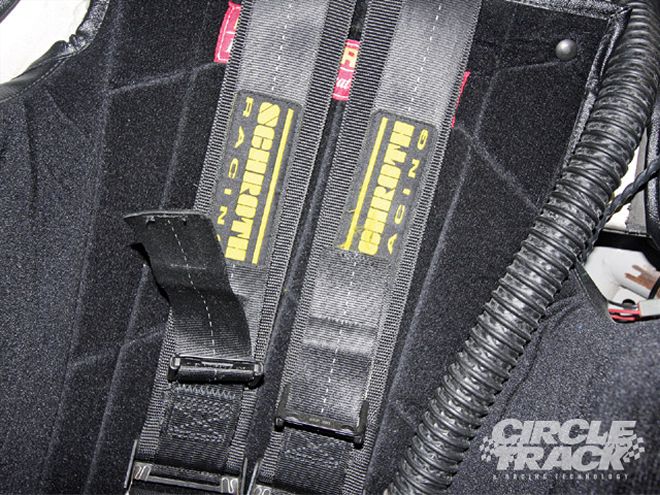 Here is Schroth's six-point harness, notice the webbing detail on the belt. Seatbelts are woven in a way that increases their strength. NASCAR rulebooks say that the belts must be able to hold an incredible 15,000 pounds of dead weight. Photo by John Gibson
Here is Schroth's six-point harness, notice the webbing detail on the belt. Seatbelts are woven in a way that increases their strength. NASCAR rulebooks say that the belts must be able to hold an incredible 15,000 pounds of dead weight. Photo by John Gibson
You should also check for any type of fraying that might be occurring on the belt. This will significantly reduce the strength of the belt. The woven pattern of the seatbelts will help prevent this fraying but it can still happen. Usually, it will start out as a small cut and then it will fray the edges over time. If they start to become frayed, then it's time to replace the belts.
One of the other things you need to inspect is your mounting brackets. You can avoid doing this every week, but after any type of accident always pull the Grade 8 bolt out and inspect it for any bends and look at the bracket itself to ensure it has no bends or warps in it. If either has been compromised, then you should replace them before the next race. It all comes back to not settling for faulty equipment.
I will admit that I have been guilty of running aged belts as well, but most sanctioning bodies are now cracking down on teams doing this. You should replace your belts every two years and definitely sooner if you discover any type of cuts or fraying. The SFI safety rating makes it extremely difficult to even get around the safety inspection at your local racetrack anymore.
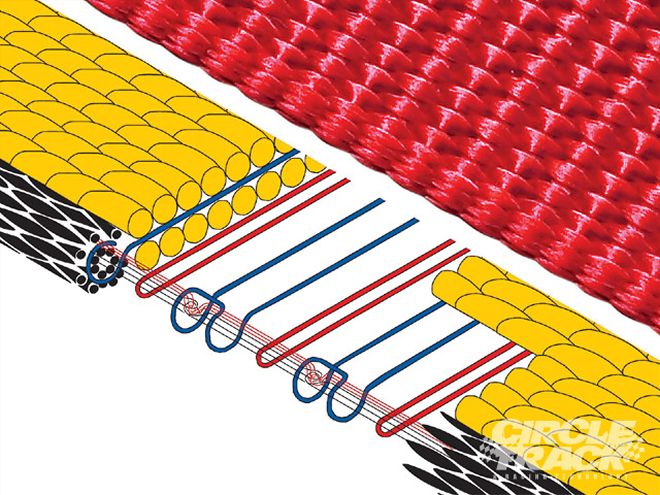 Unique to Schroth is the "memory effect" designed into the webbing. Special monofilaments laterally woven in perform like small leaf springs and keep the webbing flat. This results in better load spreading over the full width of the Schroth webbing. An additional advantage of the Schroth webbing: The special weaving technology forms round edges for additional comfort. Courtesy of Schroth Harnesses
Unique to Schroth is the "memory effect" designed into the webbing. Special monofilaments laterally woven in perform like small leaf springs and keep the webbing flat. This results in better load spreading over the full width of the Schroth webbing. An additional advantage of the Schroth webbing: The special weaving technology forms round edges for additional comfort. Courtesy of Schroth Harnesses
The date the belts expire are posted right on the seatbelt. There is no reason to be running outdated belts. I can assure you that date is not posted on there just so the companies can make money off of your team buying belts every two seasons. The belts just experience so much stress during an accident that running outdated belts could be potentially dangerous.
So what if you have run two seasons on a set of belts and they look perfectly fine? You've done a good job of keeping your car out of the wall, and you've kept your belts in top-notch shape. But now your sanctioning body is telling you that you have to spend the money on getting a new set of belts. It sounds unfair, doesn't it?
Well, G-Force Racing Gear has a program just for these types of situations, but it also works for seatbelts that have been cut or frayed. They call it their re-webbing program. You can send back your outdated or damaged belts to their location in Roswell, Georgia, and they will spend two to three weeks inspecting the belts for wear, discarding the old webbing and replacing it with new as necessary. The best thing about this program is that it not only saves you money, but G-Force will also recertify the belts, replacing the crucial outdated SFI safety label with a brand-new one that will ensure another two years of use.
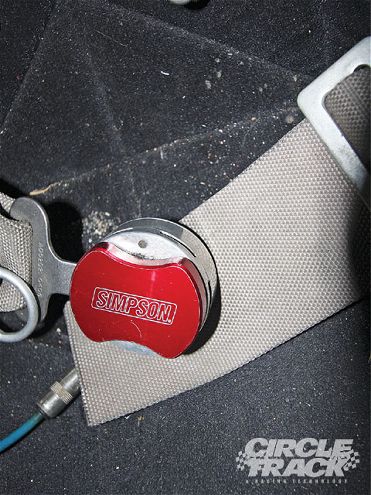 This is a standard cam-lock setup from Simpson. Photo by John Gibson
This is a standard cam-lock setup from Simpson. Photo by John Gibson
Conclusion The safety revolution has really taken off in the past 10 years in the racing world, and rightfully so; cars are faster than ever. Unfortunately, teams often forget how dangerous racing really is, and in the crunch to make every dollar go as far as possible, the temptation is to spend those precious dollars on performance items instead of safety items. Do everything to make certain that you do not fall into these traps. All it takes is the failure of a key safety item during an accident, and the money you saved by not replacing the item is wasted in medical bills.
But it's not just money; it's also a time issue. Most racers I know work full-time jobs outside of racing. When you are pressed for time, with every minute going to taking care of maintenance, repairs, and setup for the next race, items such as seatbelts can so easily be overlooked. Doing so routinely, however, is a dangerous practice and sets you up for failure. Consider adding a quick inspection of your seatbelts to your pre-race checklist that you use in the shop. It doesn't have to be a long, tedious process. Simply glancing at your belts from week to week will go a long way to ensuring yours or your driver's safety.